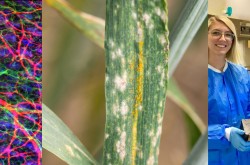3 things you should know about growing seeds, clinical trials and exploring Mars


Meet Renée-Claude Goulet, Jesse Rogerson, and Michelle Campbell Mekarski.
They are Ingenium’s science advisors, providing expert scientific advice on key subjects relating to our three museums — the Canada Agriculture and Food Museum, the Canada Aviation and Space Museum, and the Canada Science and Technology Museum.
In this colourful monthly blog series, Ingenium’s science advisors offer up three quirky nuggets related to their areas of expertise. For the May edition, our science advisors focused on indoor gardening, the stages of a clinical trial, and a new way to explore Mars.

An artist’s rendering of Ingenuity, a small drone-like helicopter, sitting on the surface of Mars.
A new way to explore Mars
This summer, NASA plans to launch a new robotic mission to Mars: the Perseverance Rover. It is designed much like its predecessor, the Curiosity Rover, but its mission is wholly different: it will be searching for signs of ancient life on the planet, and collecting rock and soil samples for return to Earth.
But attached to the underside of this rover is something you might not expect to be sent to another planet: a helicopter!
To date, humans have developed three main types of robotic explorers for the solar system. Satellites, used in fly-by or orbiting missions, are designed to remain in space and look down at the planets. Satellites cover lots of ground, but from hundreds or thousands of kilometres away. The second type are landers, which descend to the surface and stay where they land. They can measure the planet directly, but only a very small part of it. The third type are rovers, which can move several kilometres from where they land.
With the launch of the Perseverance Rover, NASA will be testing out a brand-new technology that could change how we explore other planets. A small, drone-like helicopter named Ingenuity will accompany the rover as a technological demonstration; it will be deployed for a series of powered flight tests. Flights will be up to 90 seconds long, and could be as far 300 metres, all while hovering around five metres off the ground. If successful, Ingenuity will be the first powered flight on another planet.
So why do we need to have powered flight on another planet? Because it means we can cover more ground! A helicopter like Ingenuity would be able to move much further and faster than a rover ever could, while still performing scientific measurements up close. Ingenuity may very well mark the beginning of a new era of planetary exploration.
By Jesse Rogerson

Why does it take so long to a new drug to be approved? Because they need to be carefully checked for safety and efficacy.
Searching for a cure: Steps in a clinical trial
Imagine a new drug is invented to cure malaria, cancer, or the coronavirus. Though this could be game-changing, it can’t just be released to the world. Human bodies are very complex things. A drug that works in a test tube full of cells — or on a mouse — could have completely different effects on a person. To ensure that a new treatment or therapy works as intended without serious side effects, it must go through clinical trials.
Clinical trials happen in four stages, each designed to answer questions about how the treatment works in people. To protect potential patients, researchers must submit existing research and a plan describing the potential trial before each stage. This information is examined by scientists, doctors, and other experts to make sure the treatment looks promising, and the trial is well designed. If the treatment is determined to be unsafe or ineffective at any point (before or during trials), it will not continue.
PHASE 1 is about immediate safety. In this phase, a very small number of volunteers receive the experimental treatment. The goal is to find out how the treatment affects the body, if the treatment is safe to administer, and in what dose. Researchers watch the subjects closely for any major side effects. Most experimental treatments make it through this stage.
PHASE 2 evaluates whether the treatment works for people with a certain disease. This phase generally includes a couple hundred people and lasts months to years. Dosage is also tested in order to maximize effectiveness and minimize side effects. About a third of experimental treatments complete this stage.
PHASE 3 involves hundreds to thousands of patients, usually over several years. The large scale gives researchers a much better idea of the treatment’s safety and efficacy. The experimental treatment is directly compared to existing treatments for the same disease or condition. If a therapy successfully completes this stage, it can be released into the public market. Of all the treatments that start clinical trials, about 14 per cent gain approval at this point.
PHASE 4 is a surveillance period after the treatment has been publically released. Benefits and long-term effects will be monitored for different groups of patients, and in combination with other treatments. As a result, less common effects can be detected. Adverse results from phase 4 studies can result in a treatment being restricted or even taken off the market.
While the process is long, each step in a clinical trial is designed to find the most effective and safe treatments while minimizing the risks to patients.
By Michelle Campbell Mekarski

Some of these spinach seedlings have stretched up towards the light.
How to avoid 3 common indoor gardening problems
Faced with the social distancing rules imposed by COVID-19, people are finding all types of activities to keep busy at home — and gardening is definitely one of them! Whether you’re just discovering your green thumb or you're a seasoned gardener, starting seeds indoors is a great place to start. Here are three pieces of science-based advice to help you get the most out of your hard work, and avoid some common seed-starting pitfalls!
Problem #1: Seedlings are stretched out, thin or weak, and don’t stand on their own. Cause: Not enough light.
Our windows filter sunlight, reducing its intensity and quality. Seedlings stretch to find the light. The ideal solution to avoid long skinny seedlings is growing them under a grow-light, with the bulb close to the plants (without touching them). If that isn’t an option, having the seedlings in a south-facing window will help them get the most sun exposure. You can’t undo stretchiness, but you can plant the seedling at the bottom of a deeper container and bury it up to its first set of leaves.
Problem #2: Seedling stems have rotted at the bottom, or plants are turning yellow, are wilted or are not growing, Cause: too much water.
This may seem strange but for plants, too much water is just as bad as too little. Roots need oxygen to function and grow, which they get from air filled spaces in the soil. If soil is constantly saturated, the roots essentially drown. Damp conditions also are a breeding ground for fungi and bacteria, which can kill the seedlings (with diseases such as damping off). Keep a lid or a plastic sheet on your seedling tray to keep in moisture until the plants have sprouted and mostly shed the seed envelope (otherwise it could dry, trapping the leaves inside). Then continue growing without the cover and water only when soil is dry. Do not completely soak the soil (make sure your containers have draining holes).
Problem #3: Plants are delicate and weak, or died when put outside. Cause: Plants are too coddled.
Inside, the plants have it really easy — no wind, no big temperature fluctuations, very few damaging UV rays (again, windows filter light). Plants respond to stressors in different ways, one of them being growing stronger. Make life a little tougher for your indoor seedlings; point a fan at them (on low), and once they’re bigger, pinch off the tops to make them grow side shoots. Before planting outdoors, leave them outside progressively longer every day so they can get used to the wind and the direct sunlight. Eventually they will be strong enough to be outside full time.
Nursing seedlings through the delicate first stages of their lives to transplant-readiness can be frustrating at times, but these tips should get you well on your way to a successful garden.
By Renée-Claude Goulet














